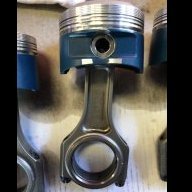Announcements
-
Similar Content
-
Latest Posts
-
There's nothing that some paddle pop sticks and extra cable ties can't fix.
-
Hey guys, so Golebys has good prices on Bosch injectors, and also sell an adaptor to go from 1/2 length injector to standard with the Nissan 10.5mm top seal. Does anyone know if that adaptor is to suit the 14mm or 11mm injector tops? And re. The bottom seal, to suit my standard RB20 intake, would I be right in saying I can just slip the 14mm square section O ring over the bottom of the new injector and done? Thanks in advance guy, Cheers, Rowdy
-
F my life. I was changing the oil on my R32 GTR today as usual and ran into a bit of a snag. I drained the oil out and was getting ready to finish the job by tightening the drain plug, however The stupid magnetic oil drain plug snapped in half, right at the magnet part. After about an hour of trying to remove it, I used a drill bit, which unfortunately pushed the magnet all the way into the pan, and just leaving the hollow threaded part of the bolt remaining. I was able to remove the hollow portion of the bolt from the oil pan with some pliers but the magnet is still in there. So, the question is, should I drop the oil pan to get the magnet piece out, or is it okay to leave it in there? I really dont want to drop the pan, i'm about to go nuts. PSA: Do NOT buy a BLOX magnetic drain plug. This is the one i had. https://bloxracing.com/products/magnetic-oil-drain-plug-m12x1-25mm?variant=37131252859052&country=US¤cy=USD&utm_medium=product_sync&utm_source=google&utm_content=sag_organic&utm_campaign=sag_organic&gad_source=1&gclid=CjwKCAjw47i_BhBTEiwAaJfPpgti1D2JwO7TDuMpXuqeQPCuIQSAfwxpWQH5rF9MD7sm5SCZDWLR_RoC_YoQAvD_BwE
-
I actually have an aftermarket hanger, the detschwerks x1 hanger, but my dw420 has never really sat in it correctly, good to know I can just modify it a bit to suit. Yeah cheers man will definitely have a play with it and hope it solves my dramas.
-
Seriously though, it's the Shaft Autoservice high mount rear spoiler: https://az-style.shop/items/5ffaad5a72eb464137a6edb1
-




Recommended Posts
Create an account or sign in to comment
You need to be a member in order to leave a comment
Create an account
Sign up for a new account in our community. It's easy!
Register a new accountSign in
Already have an account? Sign in here.
Sign In Now